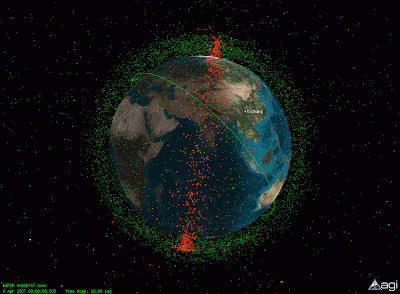China’s ASAT – The Problem With Debris (Part II)

Well, can’t say YHS was entirely surprised. As we first discussed here, the repercussions of this type of test would be felt for sometime. Comes now today an article from Reuters wherein we find the debris field to be larger than first expected:
U.S. DETAILS CHINA SATELLITE DEBRIS, Reuters, April 11, 2007. A larger than previously reported debris field from China’s anti-satellite test in January has boosted risks to spacecraft in a wide range of orbits, the U.S. Air Force Space Command said on Tuesday. … The test “made clear that space is not a sanctuary,” Ronald Sega, undersecretary of the Air Force, told reporters at a space-industry forum in Colorado Springs, Colorado. … The Space Command is tracking more than 1,600 pieces of the Chinese target, the Feng Yun 1C weather satellite, and most are expected to remain in orbit for “decades,” Masao Doi, a command spokesman, said in an e-mail. … With about 10 countries and consortia able to launch payloads into space and about 40 countries owning assets in orbit, “space debris affects us all,” Doi said. “The need to protect our space capabilities is as important now as ever and robust space situational awareness is critical to performing this function,” he said. …(emphasis added)

View of LEO Satellites (green) and Debris Ring (red) from Chinese ASAT Test
STK-generated images courtesy of CSSI (www.centerforspace.com)
Want to learn more about on-orbit debris? Check out this NASA study from 2003 which is an exhaustive collection of debris events up to that date.

One Comment
Comments are closed.